- Recent Updates
- Colpoy's Bay
- Colpoy's Bay Introduction
- Spragge's Hill
- The Kalbfleisch House
- The Kalbfleisch Dock
- The Kalbfleisch Marina
- Whicher's Sawmill
- The Wrecks Near Whicher's Mill
- Frame's Falls and John Wood's Grist Mill
- Albemarle Street
- Hughenden and Whicher's Store
- The Community Hall
- The Forest Home Hotel
- The Colpoy's Bay Schoolhouse
- The Colpoy's Bay Church
- Edgehill Cemetery
- Colpoy's Bay From the Air
- A Glimpse of the Past
- Wiarton
- Berford Street
- Berford St. Part 2
- Berford St. Part 3
- Wiarton Harbour
- Bluewater Beach
- Caframo Ltd. and Wiarton Cement Works
- Wiarton Beet Sugar Factory
- Wiarton's Hotels
- Wiarton's Schools
- Wiarton's Banks
- Grand Trunk Railway Station
- The Wiarton Fish House
- The Wiarton Fish Hatchery
- Wiarton's Berford Theatre
- The Wiarton Woolen Mills
- Wiarton's Furniture Industry
- Wiarton's Hospital
- Wiarton's War Memorial
- Wiarton's Town Hall
- Wiarton's Newspapers
- Wiarton's Grist & Flour Mills
- Wiarton's Sawmill Industry
- Wiarton's Gateway
- Connecting Passages
(Links) - Present-day Map
of Colpoy's Bay - Colpoy's Bay
Lot Map (1870) 
Wiarton Timeline- Present-day Map
of Wiarton - Bibliography
- About the Author
- Site Map
(use if menu doesn't work) - Tell me your impressions!
The Wiarton Woolen Mills
When the Wiarton Echo newspaper debuted in July of 1879, it came just in time to advertise the coming of one of the village's first staple factories, the Wiarton Woollen Mills. Originally known as the Wiarton Carding Mill, the factory opened that September, supplying first-generation Wiartonians with varieties of cloth, doeskins, cashmeres, tweeds and blankets. William Tanner set up the business and housed it in a new two story frame structure on the east side of Brown Street, well away from Wiarton's early commercial centre of Gould Street. Nonetheless, the business, which soon became known simple as the Wiarton Woolen Mills, proved successful for Mr. Tanner until he sold it in 1896. Figure W15A shows the original woolen mills, likely in the days of Mr. Tanner's ownership.
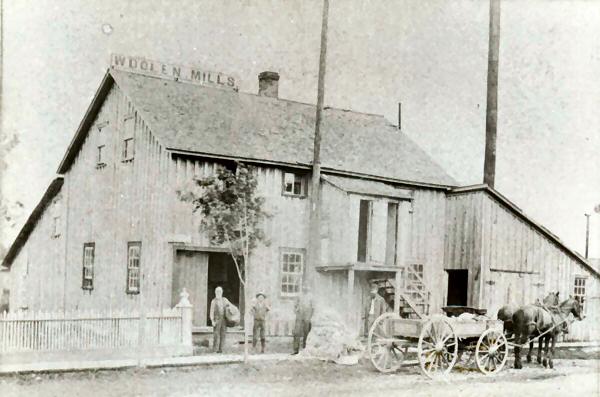
Figure W15A: The original Wiarton Woolen Mills (sometime between 1879 and 1903).
Upon its sale by William Tanner, the woolen mills were incorporated as a business (Wiarton Woolen Mills Company) with local townspeople making up the board of directors. Despite at least one change in management, the profitability of the operation suffered in the years to come, leading to a declaration of bankruptcy in early February 1900. All the assets of the mills were then purchased by Porter, Leith and Company for $1350 (over $30 000 in today's money), with operations resuming in April of the same year.
Porter, Leith and Company restored the business to financial soundness over the next two years before selling the mills to local businessman B.B. Freeman. It was about a year before Freeman decided to completely reconstruct the Wiarton Woolen Mills with a much larger, and more modern facility. After bargaining for partial tax exemption, Freeman began excavation for his imposing new structure one lot south of the original mills. The new building featured 12 foot ceilings and was built of solid limestone from a local quarry and stood 42' by 80' and three storeys tall (with an adjoining 20' by 32' boiler room). Given that it was built on marshland, the new mills also required cement foundations that ran as deep into the ground as the building was tall. At the same time, Freeman moved the original mills to the rear of the new building to serve as storage. (Although the footings still remain where the original mills were moved, the structure appears to have been dismantled sometime before 1939.)
Under Mr. Freeman's control, the firm became known as the Freeman Woolen Company. When it opened in September of 1903, the $10 000 (over $220 000 in today's currency) in equipment that Freeman installed was being run by a staff of 25 employees. Advertisements of the day show that the woolen mills were turning out blankets, yarns, tweeds and flannels, among other things.
My research has yet to reveal the details of what happened to the Wiarton Woolen Mills in the following years. In general terms, it appears the building was used for its original purpose for perhaps only five more years. After that, it served as a shingle mill with war production added during World War One. I suspect that Figure W15C shows the former woolen mills building operating as a shingle mill.
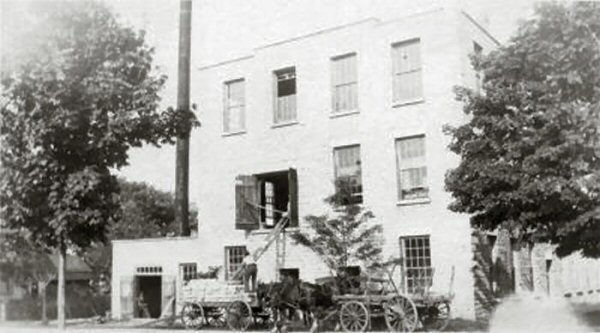
Figure W15C: Former Wiarton Woolen Mill as a shingle mill around 1920.
During the intra-war period, the building continued to serve as a shingle mill, as well as a warehouse for some trucking companies. This continued until the end of World War II, with war production again taking place from 1939 - 1945. Following WWII, Bruce County used much of the building for storage, and part of the building was also used for the manufacture of the Wishing Well brand of soft drinks. Wishing Well cleared out their operations in the mid to late 1950s, after which the former woolen mills were used as storage for a local furniture store, with the front portion of the first floor occupied by Brough and Whicher's Windows and Doors.
In 1960 Jim Barfoot purchased the sizeable structure to house his welding business. When I visited him in 2000, his operations were mainly out of the first floor, with the top two floors of the building used maily as storage). Mr. Barfoot undertook important engineering measures to ensure the structure will continue to stand long into the future. Mr. Barfoot passed away in 2019. The building continues to serve a similar line of business under the name of Thompson Machine and Millwright. Figure W15D shows two vantages of the building in 2000 as well as the same views in 2023.
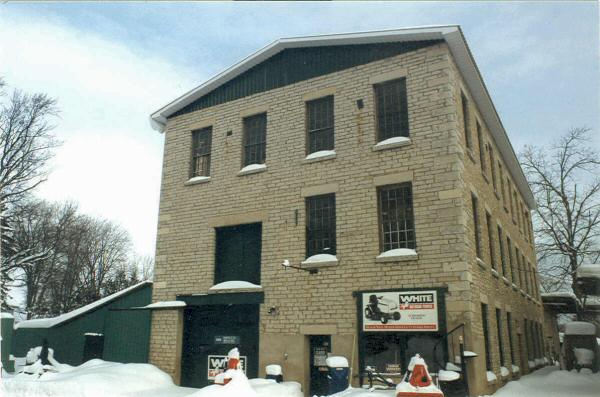
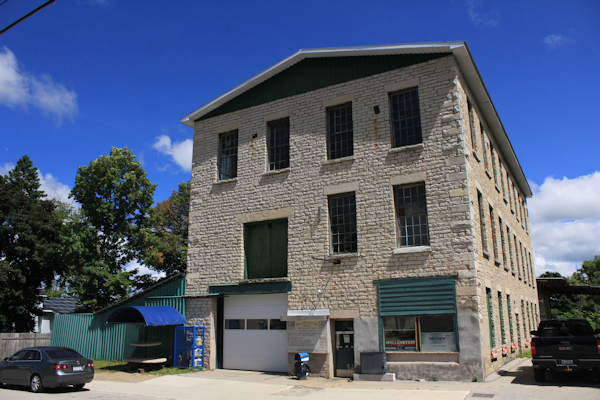
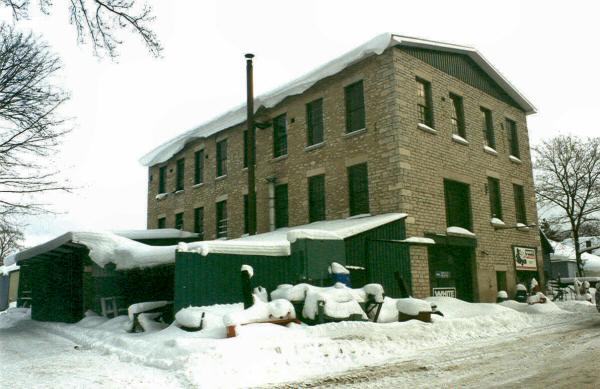
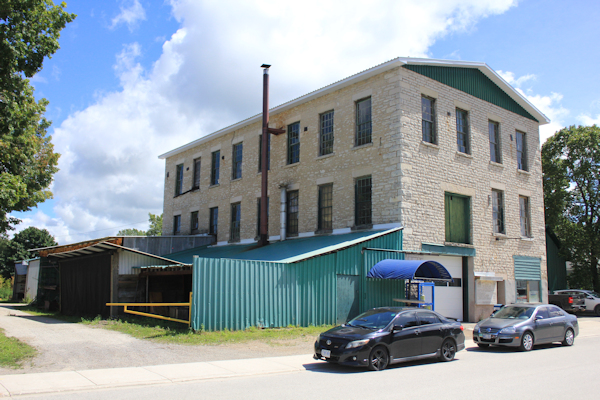
Figure W15D: Former Wiarton Woollen Mill shown as Barfoot's Welding in 2000 and Thompson Machine and Millwright in 2023. (2000, 2023, 2000, 2023)
While the building now sports a pitched roof, the main structure looks much the same as it did when it was first built. This unique building marks the enduring legacy of the enterprising efforts of William Tanner, B.B. Freeman, Mr. Barfoot and others.

